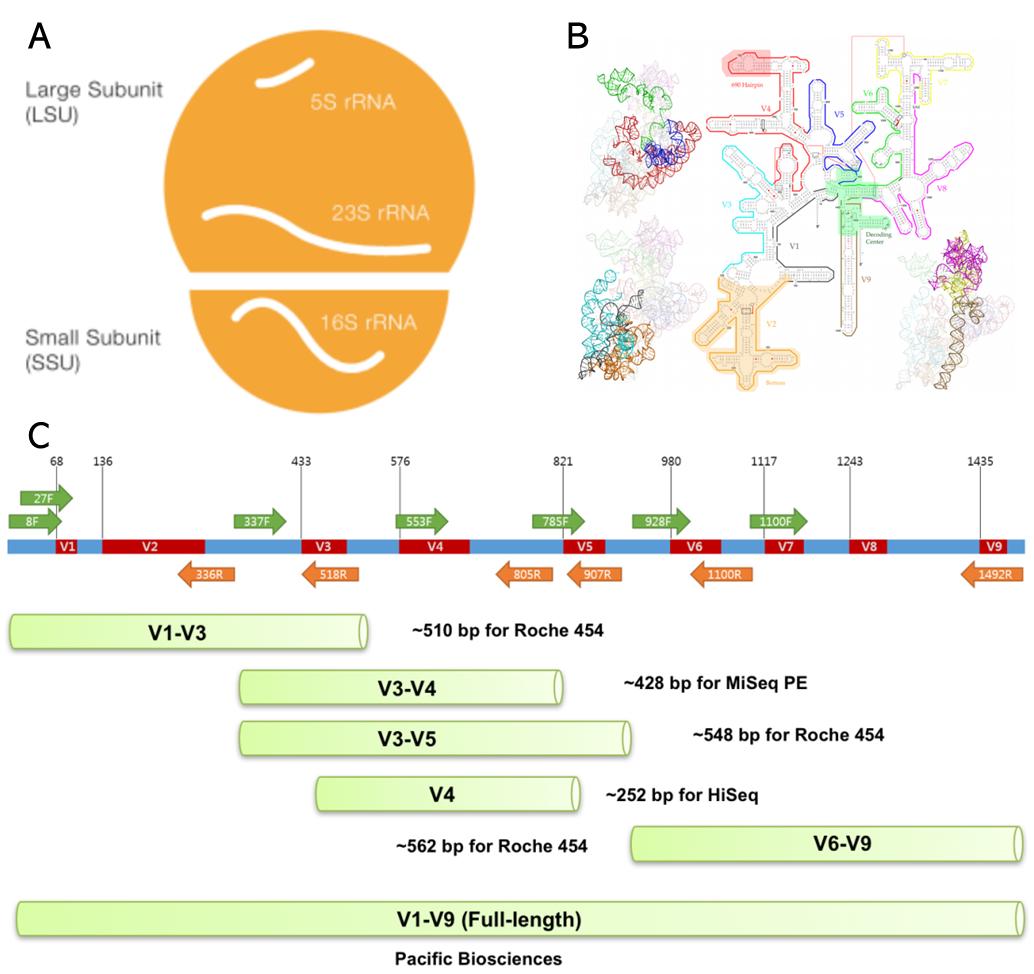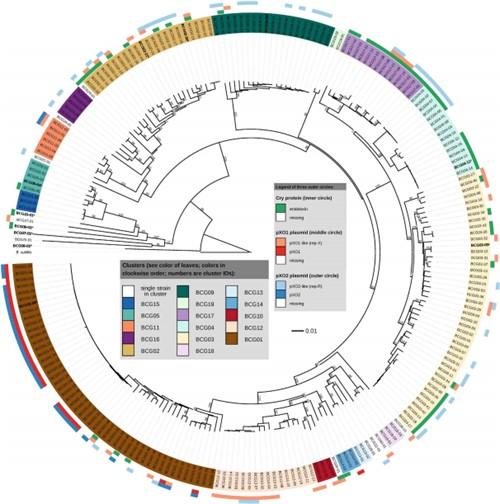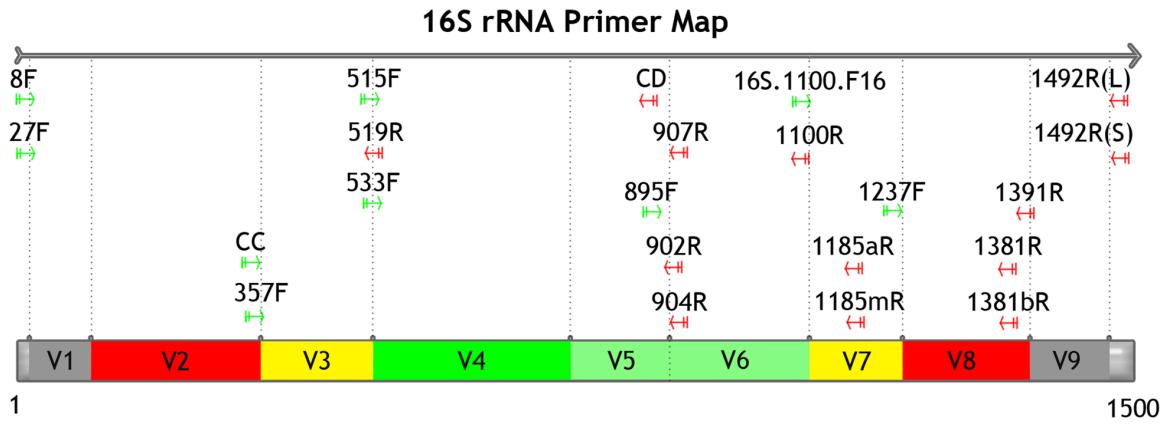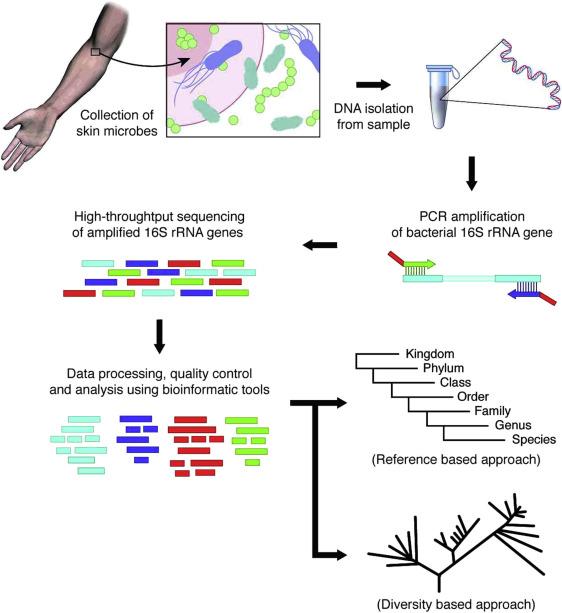What Is 16S rRNA?
The 16S rRNA (16S ribosomal RNA) is a constituent component of the 30S subunit in prokaryotic ribosomes. The “S” in 16S pertains to the Svedberg unit, a measure that reflects the sedimentation rate of large molecules in a centrifugal field – the higher the value, the larger the molecule. The 16S rRNA gene is the DNA sequence encoding for bacterial rRNA and is found in the genomes of all bacteria. Significantly, 16S rRNA is highly conserved and highly specific, with a gene sequence of sufficient length.
Figure 1A shows how 16S rRNA is involved in a prokaryotic ribosome. The bacterial 16S rRNA gene contains nine hypervariable regions (V1-V9) ranging from 30-100 base pairs, flanked by conserved regions (Figure 1C). You can find 16S rRNA sequences in databases such as Ribosomal database project (RDP), Greengenes database, Silva, and Human microbiome project (HMP).

Figure 1. 16S rRNA gene. (A) The involvement of 16S rRNA gene in a prokaryotic ribosome. (B) The 2D and 3D structure of the 16S rRNA gene. Individual regions are shown in the same color (Yang et al. 2016). (C) The regions and primers of 16S rRNA.
Service you may intersted in
Characteristics of 16S rRNA
The 16S rRNA is a ribosomal RNA necessary for the synthesis of all prokaryotic proteins and has the following characteristics:
Multiple copies
Each bacterium contains 5~10 copies of 16S rRNA, which makes the detection sensitivity highly.
Multi information
The internal structure of 16S rRNA gene is composed of variable regions and conserved regions. The conserved area is shared by all the bacteria, and the variable regions have different degrees of difference among the different bacteria, with the specificity of the genus or species, and the variable regions and the conservative areas are interlaced. Therefore, the universal primers of various bacteria can be designed according to the conservative area, and specific primers or probes of specific bacteria can be designed according to the variable area. The interspecific differences of the information contained in the variable regions of 16S rRNA make the detection specific.
The length is moderate
The length of 16S rRNA coding gene is about 1500bp, which contains about 50 functional domains.
Promoter Region
The sequence of 16S rRNA encompasses the promoter region—an area instrumental in initiating bacterial transcription.
Core Structure
Characteristic structural features of the nucleotide sequence are present in 16S rRNA, including the loop-arrangement of single-strand RNA and the secondary structure formed by the hydrogen bonds between bases. These structures play a pivotal role in its function.
Functions of 16S rRNA
16S rRNA has a number of functions:
- The immobilization of ribosomal proteins acts as scaffolding.
- 3′ end contains a reverse SD sequence that is used to bind to the AUG initiation codon of mRNA. The combination of 16S rRNA’s 3′ end with S1 and S21 was found to be related to the initiation of protein synthesis.
- It interacts with 23S to help integrate two ribosome units. (50S+30S)
16S rRNA Gene Detection
With the advent of PCR technology and the continuous refinement of nucleic acid research techniques, 16S rRNA gene detection has emerged as a powerful tool for pathogen detection and identification. As databases evolve, this technique can be applied for the rapid, precise, and accurate classification, identification, and detection of pathogens. The process primarily involves three steps: firstly, acquiring genomic DNA; secondly, obtaining the 16S rRNA gene fragment; and finally, analyzing the sequence of the 16S rRNA gene.
16S rRNA Sequence Analysis
The fundamental principle of 16S rRNA sequence analysis technique involves acquiring 16S rRNA sequence information from microbial samples through methods such as cloning, sequencing, enzyme digestion, or probe hybridization. Subsequently, this obtained sequence data is compared with other sequences in sequence databases or 16S rRNA databases to determine its position on the evolutionary tree, thereby identifying potential microbial species present in the sample.
The analysis method of 16S rRNA gene fragment mainly includes the following 3 kinds:
(1) Sequencing the PCR products on plasmid vectors and aligning them with sequences in the 16S rRNA database enables the determination of their position on the evolutionary tree, facilitating the identification of potential microbial species present in the sample. While this method yields comprehensive information, sequencing from the sample is relatively complex and demands a considerable sequencing effort.
(2) Following the processing of PCR amplification, the resultant product is subjected to hybridization with 16S rRNA-specific probes, thus yielding valuable insights into microbial composition. Moreover, these aforementioned probes enable a direct examination through in situ hybridization with the sample. Importantly, besides determining morphological characteristics and abundance of the microorganisms, in situ hybridization also facilitates analysis of their spatial distribution.
(3) Conducting Restriction Fragment Length Polymorphism (RFLP) analysis on PCR products involves observing enzyme digestion electrophoresis patterns and performing numerical analysis to ascertain the ribotype of microbial genes. Subsequently, comparing this ribotype data with entries in ribosomal libraries enables the analysis of microbial composition in the sample and relationships among different microbial species.

Figure 2. 16S rRNA gene detection
Applications of 16S rRNA
The 16S rRNA gene is one of the most conserved genetic elements across all bacteria, serving as an enduring evolutionary hallmark. Certain gene sequences remain stable across millennia, a testament to long-term evolutionary processes. Taking advantage of the numerous copies of the bacterial chromosome, several techniques have been established based on the 16S rRNA gene. These include methods such as Polymerase Chain Reaction (PCR), nested PCR, multiplex semi-nested PCR, reverse transcription-PCR (RT-PCR), and oligonucleotide probing. Nucleic acid probes have found extensive applications in the realm of clinical microbiology, particularly in bacterial identification, sequence analysis, molecular taxonomy, and phylogenetic studies.
The Future of 16S rRNA
Ribosomal rRNA is essential for the survival of all living things. 16 S rRNA is highly conserved in the evolutionary process of bacteria and other microorganisms. It is called “the molecular fossil” of bacteria. At the same time, its conservatism is relative. There are 9 to 10 variation regions (V1 ~ V10) between the conservative areas. There are different degrees of difference in the families, genera and species of different bacteria, so 16S rRNA can be used as both It is a marker for bacterial classification and can be used as a target molecule for detection and identification of clinical pathogens. The PCR of the bacterial ribosome 16S rRNA gene as the target molecule can judge the existence of bacterial infection early and identify the species of the pathogen by further analysis of the amplified products and make up for the above deficiencies. It is an important breach in the diagnosis of infectious diseases and has become the principal of bacteriologists at home and abroad. One of the directions is to be studied.
16S rRNA as Molecular Marker
The 16S rRNA gene, due to its universal presence and unique evolutionary characteristics, has been widely recognized as a pivotal molecular marker in microbial ecology. Pioneering work by Carl Woese and George E. Fox heralded its use in phylogenetic studies. As noted by Yang et al., red zones (namely V2 and V8) in 16S rRNA, as illustrated in Figure 3, tend to exhibit a lower resolution at the phylum level. In contrast, green zones (specifically V4, V5, and V6) correlate with the shortest geodesic distance, suggesting they may be superior choices for phylogenetically oriented analyses, including those focusing on the delineation of novel bacterial phyla.

Figure 3. Illustration of different variable regions (Yang et al. 2016).
16S rRNA Sequencing
Sequencing of 16S rRNA generally utilizes next or third-generation sequencing techniques to read one or several regions of the 16S rRNA, which has been amplified through pertinent universal primers resulting in PCR products. The platforms commonly employed for 16S rRNA sequencing comprise of Illumina MiSeq, Roche 454, Illumina MiSeq/HiSeq, and Pacific Bioscience. The first three platforms each read only cover approximately 100 to 600 base pairs, while Pacific Bioscience is capable of producing the full length of 16S rRNA.
Table 1. The common 16S rRNA sequencing regions by various platforms.
|
Platform
|
Common Sequencing regions
|
|
Illumina MiSeq
|
V3-V4, about 428 bp
|
|
Roche 454
|
V1-V3, about 510 bp;
V3-V5, about 428 bp; V6-V9, about 548 bp |
|
Illumina HiSeq
|
V4, about 252 bp
|
|
Pacific Bioscience
|
V1-V9 (full-length), about 1500 bp
|
16S rRNA Sequencing Process
The 16S rRNA sequencing workflow encompasses several key steps, including genomic DNA extraction, targeted PCR amplification, library construction, sequencing, and bioinformatics analysis.

Figure 4 16S rRNA Sequencing Process
During sample collection, meticulous care is taken to prevent contamination and preserve sample integrity. Subsequently extracted DNA undergoes rigorous quality and concentration assessments. PCR amplification targeting specific regions of the 16S rRNA gene is conducted using gene-specific primers. Optimization of PCR conditions is crucial to ensure specificity and amplification efficiency. Following amplification, gel electrophoresis is employed to verify the size and purity of PCR products. Purification of PCR products from the reaction system is then accomplished using gel extraction kits or PCR product purification kits.
The next steps involve the construction of the sequencing library and the sequencing workflow, with 16S rRNA sequencing generally employing short read lengths to cover specific areas of the 16S rRNA gene. The final phase involves quality control and filtering of the sequencing data, followed by utilization of 16S rRNA sequence analysis software (such as QIIME or mothur) to undertake clustering, annotating, and classifying sequences. This includes creating Operational Taxonomic Units or Amplicon Sequence Variants, taxonomic annotation, and diversity analysis. Furthermore, the outcomes can be used to compare microbial compositions across different samples, exploring the relationships between microbial community structures and environmental factors, with potential statistical analyses conducted to verify any observed disparities.
Advantages of 16S rRNA sequencing
As a rapid, high-throughput, and culture-free technique, 16S rRNA sequencing provides an essential toolset and technological underpinning to profoundly comprehend the structure, functionality, and dynamic alterations within microbial communities.
Foremost, the conservation and diversity of the 16S rRNA gene — ubiquitously found in both bacteria and archaea with varying degrees of sequence divergence across species — endorse its utility in identifying and comparing the member composition of distinct microbial communities. Unlike conventional microbiological techniques that often demand culture and isolation of microbes, 16S rRNA sequencing proffers investigation of microbial communities without the prerequisite of prior cultivation. This holds significant convenience for studying microbial groups that resist cultivation or remain unknown. As the advent of high-throughput sequencing technology continues to unfurl, thousands of 16S rRNA sequences can now be sequenced at once. This high-throughput property optimally enables large-scale, comprehensive analysis of members within microbial communities, thereby enhancing our understanding of the nature and functionality of microbial ecosystems.
Microbial diversity research extensively employs 16S rRNA sequencing. By analyzing 16S rRNA sequences in different samples, we can understand the species composition, abundance distribution, and community structure of microbial groups. This subsequently aids researching the diversity of microbial communities and their roles within ecological systems. In the sphere of metagenomics research, the integration of 16S rRNA sequencing with other “omics” methodologies — such as genomics, transcriptomics, and metabolomics — offers a holistic examination of the structure and functionality of microbial communities. This integrative approach can reveal survival strategies, metabolic pathways, and interaction patterns of microbes in varying environments. Clinically, 16S rRNA sequencing finds a vast gamut of applications in the field of clinical microbiology. For instance, it aids in analyzing disease-related microbial communities, identifying antibiotic-resistant strains, and carrying out associated studies probing the linkage between microbial communities and host health.
Applications of 16S rRNA Sequencing
With the progression of high-throughput sequencing technologies, contemporary sequencing platforms can swiftly and efficiently perform 16S rRNA sequencing of numerous samples, thereby acquiring an abundant data load in a relatively short period. This technological advancement enables comprehensive, large-scale inquiries into microbial communities. Applicable to various sample types, the 16S rRNA sequencing serves in the study of microbial communities under diverse environmental conditions, including but not limited to soil, water bodies, foodstuffs, and organisms.
Consequently, it holds vast application prospects within the realms of environmental science, medicine, food safety, et cetera. For detailed applications, refer to the section on 16S rRNA sequencing applications.

Figure 5. The workflow of 16S rRNA sequencing for human microbiome analysis.
References:
- Case R J, Boucher Y, Dahllöf I, et al. Use of 16S rRNA and rpoB genes as molecular markers for microbial ecology studies. Applied and environmental microbiology, 2007, 73(1): 278-288.
- Yang B, Wang Y, Qian P Y. Sensitivity and correlation of hypervariable regions in 16S rRNA genes in phylogenetic analysis. BMC bioinformatics, 2016, 17(1): 135.

Leave a Reply